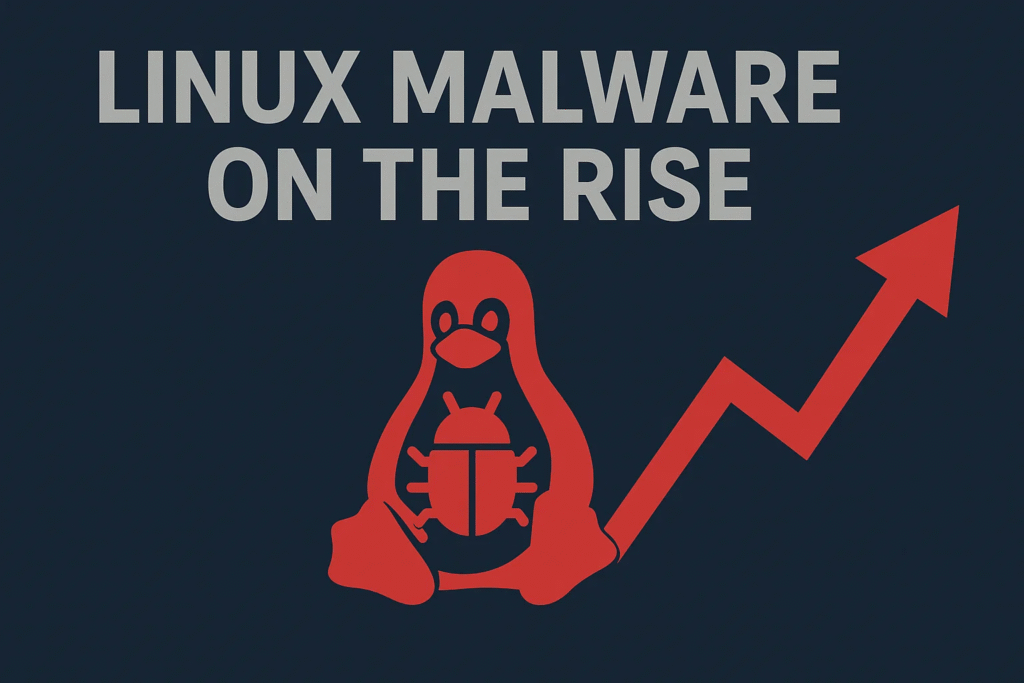Introduction
For years, Linux was considered one of the most secure operating systems, often marketed as “virus-proof” compared to Windows. While it’s true that Linux’s design and user privilege system make it inherently more secure, the landscape has changed dramatically. With the rise of cloud servers, IoT devices, and containerized environments, Linux now powers most of the internet’s infrastructure. This popularity has also made it an attractive target for cybercriminals.
In recent years, malware specifically targeting Linux systems has been on the rise. Attackers now exploit misconfigurations, outdated software, and unmonitored devices to deploy ransomware, crypto miners, rootkits, and even advanced persistent threats (APTs). As businesses and individuals increasingly rely on Linux servers and desktops, it’s crucial to understand the threat landscape and adopt best practices to stay safe.
Why Linux Malware is on the Rise
-
Growing Server Market Share: Over 90% of the top one million web servers run on Linux-based systems. This huge adoption provides cybercriminals with more opportunities.
-
Cloud and IoT Explosion: Devices running Linux kernels — from routers to smart appliances — are often left unpatched and vulnerable.
-
Open Source Does Not Equal Invulnerability: While open-source software benefits from community scrutiny, attackers can also inspect the same code for weaknesses.
-
Rise of Automated Exploits: Cybercriminals use automated tools and botnets to scan the internet for unpatched Linux servers and exploit vulnerabilities at scale.
Common Types of Linux Malware
| Malware Type | Description | Real-World Example |
|---|---|---|
| Ransomware | Encrypts files on Linux servers, demanding payment to unlock them. | RansomEXX, DarkSide |
| Cryptojackers | Use server resources to mine cryptocurrency without permission. | WatchDog, Kinsing |
| Rootkits | Hide malicious activity from system administrators and security tools. | Diamorphine, Reptile |
| Botnets | Compromise IoT and Linux servers to conduct DDoS attacks. | Mirai, Mozi |
| Web Shells | Allow attackers to remotely execute commands on compromised servers. | China Chopper |
| Backdoors | Secret access channels into Linux systems for persistent control. | BPFDoor, SSH backdoors |
The Impact of Linux Malware on Businesses
-
Service Downtime: Malware can cripple production servers, leading to downtime and loss of revenue.
-
Data Breaches: Sensitive customer and business data may be exposed or stolen.
-
Financial Losses: Ransom payments, recovery costs, and regulatory fines can be devastating.
-
Reputation Damage: Trust takes years to build but seconds to lose after a publicized breach.
9 Ways to Protect Your Linux Systems from Malware
Below is a table summarizing the nine ways you can protect your systems, followed by detailed explanations of each.
| # | Method | What It Does |
|---|---|---|
| 1 | Keep Systems Updated | Regularly apply patches to Linux OS and software. |
| 2 | Use Least Privilege Principle | Limit user and process permissions to reduce risk. |
| 3 | Install and Configure Firewalls | Control inbound and outbound traffic to block malicious activity. |
| 4 | Deploy Malware Scanners & IDS/IPS | Detect and respond to suspicious activity in real-time. |
| 5 | Secure SSH Access | Harden remote access by using key-based authentication and non-standard ports. |
| 6 | Regular Backups & Disaster Recovery | Prepare for ransomware and accidental data loss. |
| 7 | Monitor System Logs | Identify unusual behavior early through logging and alerting. |
| 8 | Disable Unnecessary Services | Reduce attack surface by running only essential services. |
| 9 | Train Administrators & Users | Improve security awareness and response readiness. |
1. Keep Systems Updated
One of the simplest yet most effective defenses is to keep your Linux operating system and all installed applications up to date. Patch management is often overlooked on servers, but outdated software provides cybercriminals with easy entry points.
-
Enable automatic security updates where possible.
-
Subscribe to distribution security advisories (e.g., Ubuntu Security Notices, Red Hat Security Announcements).
-
Test updates in a staging environment before applying to production servers.
2. Use the Least Privilege Principle
Linux’s permission system allows you to control which users and processes can access specific files or execute commands. By following the least privilege principle, you limit the damage malware can cause if it infiltrates your system.
-
Create non-root user accounts for daily operations.
-
Use
sudofor elevated privileges instead of logging in as root. -
Employ access control lists (ACLs) to fine-tune file permissions.
3. Install and Configure Firewalls
A properly configured firewall helps prevent unauthorized network access. Linux offers several firewall solutions:
-
Use iptables or nftables to set custom rules.
-
Consider firewalld for easier management on Red Hat-based systems.
-
Restrict access to only necessary ports (e.g., 80/443 for web servers).
By limiting exposed services, you reduce the opportunities for malware to exploit vulnerabilities.
4. Deploy Malware Scanners & IDS/IPS
While Linux malware detection tools are not as widely used as on Windows, there are several effective options:
-
ClamAV: An open-source antivirus engine.
-
Chkrootkit and rkhunter: Detect rootkits and suspicious files.
-
OSSEC or Wazuh: Host-based intrusion detection systems (HIDS).
-
Snort or Suricata: Network intrusion detection/prevention systems (IDS/IPS).
Deploy these tools in layers for defense in depth.
5. Secure SSH Access
Since SSH is the primary way administrators access Linux servers, it’s also a major attack vector. Hardening SSH significantly improves security.
-
Disable password authentication and use SSH keys instead.
-
Change the default port (22) to a non-standard one to reduce brute-force attempts.
-
Use tools like Fail2ban to block repeated failed login attempts.
-
Restrict SSH access to specific IP addresses if possible.
6. Regular Backups & Disaster Recovery
No matter how robust your security measures are, breaches can still happen. Regular backups ensure you can recover quickly from ransomware or accidental data loss.
-
Use incremental and full backups.
-
Store backups offline or in a secure, isolated environment.
-
Test your disaster recovery plan periodically to ensure it works when needed.
7. Monitor System Logs
Linux generates a wealth of logs that can reveal malicious activity. By actively monitoring and analyzing these logs, you can detect intrusions early.
-
Use tools like journalctl, logwatch, or syslog-ng.
-
Forward logs to a centralized system for analysis.
-
Implement real-time alerting for suspicious activity.
8. Disable Unnecessary Services
Every service running on your server is a potential entry point for attackers. By minimizing the number of active services, you shrink your attack surface.
-
Use
systemctl list-unit-filesto identify enabled services. -
Disable or uninstall unused services and daemons.
-
Employ tools like Lynis to audit your system for unnecessary components.
9. Train Administrators & Users
Human error remains one of the biggest security risks. Training your team ensures they understand best practices and can respond effectively to incidents.
-
Provide ongoing cybersecurity awareness training.
-
Simulate phishing and social engineering attacks to test readiness.
-
Create clear security policies and incident response plans.
Additional Security Best Practices
-
SELinux/AppArmor: Enable and configure security modules to enforce mandatory access controls.
-
Two-Factor Authentication (2FA): Add an extra layer of security for SSH and administrative accounts.
-
Encrypted Communications: Always use TLS/SSL for data in transit.
-
Vulnerability Scanning: Periodically scan your systems using tools like OpenVAS or Nessus.
Case Study: A Real-World Linux Malware Attack
In 2022, the BPFDoor malware targeted Linux servers globally by exploiting misconfigured firewalls. This backdoor allowed attackers to remotely execute commands and maintain persistence even after reboots. Organizations with weak monitoring or outdated firewalls were especially vulnerable. Those who implemented the 9 measures above (especially logging, firewall hardening, and least privilege) were far less likely to be compromised.
Future of Linux Security
With Linux increasingly powering critical infrastructure, security vendors are investing more in Linux-specific solutions. We’re also seeing better defaults in distributions, such as automatic updates, security-focused kernels, and improved sandboxing. However, administrators can’t rely solely on the OS — proactive security practices remain essential.
Conclusion
Linux is no longer a niche system; it’s the backbone of modern computing. This popularity makes it a prime target for cyberattacks. While no system can be 100% secure, implementing layered defenses dramatically reduces your risk. By following the nine measures discussed in this blog — from patching and firewalls to training and monitoring — you can protect your Linux systems against today’s evolving malware threats.

